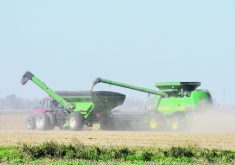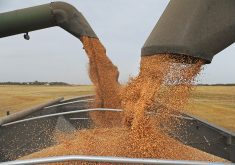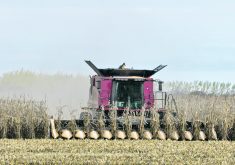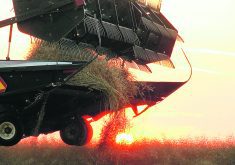Saskatchewan
South
The Moosomin area experienced a storm with high winds, hail and heavy rain, which produced 65 millimetres of precipitation and flooded many areas again.
The western part of the region missed this rain and could benefit from more precipitation.
Farmers are back in the field in the eastern part of the region, but those who have not recovered from the rain are not expected to produce a crop this year.
Topsoil moisture is continuing to improve with about 70 percent adequate in the east and about 75 percent adequate in the west.
Read Also

Manitoba community projects get support from HyLife
HyLife Fun Days 2025 donated $35,000 each to recreation and housing projects in Killarney, Steinach and Neepawa earlier this fall.
Crops in the region range from most being behind in the southeast to most being normal in the southwest.
Warm weather has helped most of the region, but blasting has damaged flowering crops such as canola.
Fall rye is 75 percent good in the southeast and soybeans are 93 percent good in the southwest.
Farmers are spraying for grasshoppers, wheat midge, cutworms, diamondback worms and cabbage seedpod weevils.
Central
Haying ranges from about 20 percent cut in the east and about 30 percent cut in the west. Quality is 85 percent good to excellent in the east and 95 percent good to excellent in the west.
About 10 percent of the hay in the east has been baled or put into silage while the west has about 20 percent. Hayland and pasture topsoil in the region is about 75 percent adequate.
The region received rain in the past week, but most areas could benefit from more to help crops advance.
Crops are behind in the west with only pulse crops rated at 60 percent normal development.
All crops in the east are behind in development with spring cereals topping the chart at about 75 percent. Soybeans in the west-central and eastern areas are almost all rated good.
North
Warm weather has helped many crops in the eastern part of the region, but crop development is still behind.
The west received rain last week that put topsoil at about 85 percent adequate for cropland and about 90 percent adequate for hay and pasture land.
Crop development is more than 50 percent normal in the west, while in the east all but fall cereals are about 50 percent behind.
Crops suffered from localized flooding, wind, insects, disease and drought-like conditions.
Soybeans in the northeast are about 60 percent good and the west has winter wheat at 95 percent good.
Haying is underway with about 20 percent cut in the east and about 30 percent cut in the west. Hay is rated at about 80 percent good in the east and 70 percent good in the west.
Farmers in this region are haying and controlling pests.
Alberta
South
Hailstorms caused moderate to severe damage.
Overall, the region has been warm and dry, which has left crops in top condition.
Some areas are having problems with cabbage seedpod weevil and lygus bugs in their canola.
Sub-surface moisture is rated 75 percent good to excellent.
Haying is well underway with irrigated yields estimated at 2.4 tons per acre and dry land at 1.7. Pasture conditions are about 77 percent good to excellent with similar ratings reported for tame hay.
Central
Growing conditions have declined because of hot, dry weather and a lack of moisture.
Stettler and Lacombe counties reported hailstorms with moderate damage.
Crop conditions are rated at about 70 percent good to excellent. Sub-surface soil moisture is about 55 percent good to excellent, and precipitation would be beneficial.
First cut haying is 25 percent complete on irrigated land and about 40 percent on dry land. Quality is rated as 90 good to excellent for irrigated hay and about 80 percent for dry land.
Northeast
The region saw 40 to 60 mm of precipitation this past week.
It has experienced warm and dry weather along with the rain. Crops are rated about 85 percent good to excellent overall with dry peas and spring wheat topping the list at about 90 percent.
Sub-surface soil moisture is at 95 percent good to excellent. Haying operations are underway with quality rated at 95 percent good to excellent. Pasture conditions are reported as about 90 percent good to excellent, with similar ratings reported for tame hay.
Northwest
Crop conditions are about 90 percent good to excellent. Spring wheat and oats are at 90 percent. Sub-surface moisture is rated 50 percent good to excellent. Pasture conditions are reported about 90 percent good to excellent.
The region has seen a long period of warm, dry weather and would benefit from more rain.
However, the hot and dry conditions have greatly benefitted haying operations, which is underway. Hay quality is at 95 percent good to excellent now that about half of dry land has been harvested.
Peace
The region is the most advanced in first cut dry land haying. Hay quality is rated at 75 percent good to excellent and dry land yield is estimated at 1.4 tons per acre.
Pasture conditions are rated at about 60 percent good to excellent.
Crops are struggling with only 50 percent rated good to excellent. Sub-surface soil moisture levels have declined about 15 percent from two weeks ago and are now rated about 70 percent.
The heat is beginning to affect yields, and rain would help crops advance.
Root maggots have started to become a concern to farmers in some areas.
Manitoba
Southwest
The region has improved in the last week with only five mm of precipitation falling. These conditions are optimal for crops in this stage of the growing season.
Early and late seeded cereal crops are on track in their development.
Northwest
Warm weather has also helped this region in the past week, but crops range from poor to excellent over the region.
Early moisture in the spring caused a lot of crop loss, yellowing and stunting. Sixty-five percent of the cereal crop is in the flowering stage and 50 percent of soybeans are in the vegetative stage.
Central
There were a few scattered showers but mostly hot and humid temperatures throughout the week.
Most crops benefited from the break in the rain, but some areas with lighter soils are starting to need precipitation.
Irrigation has begun on potatoes on light textured soils.
Early seeded broadleaf crops are faring better than the late seeded ones. Late seeded canola is flowering early because of excess moisture stress.
Fungicide treatments are up in certain areas because of wet and humid conditions and a heavy crop canopy.
Water supplies are adequate in the region.
Eastern
Rain varied from two to 13 mm, but temperatures have been warm.
The warmer temperatures have allowed producers to apply pesticides on the ground. However, planes are still busy.
Spring cereal and canola crops have not improved but the earlier seeded crops are doing better than the later seeded ones. Soybeans have improved with the warmer weather.
There have been reports of spraying for diamondback moth larvae in canola.
Haying is well under way and picking up with the help of warmer weather. Yields are reported to be normal. Pastures are in good condition.
Interlake
Some precipitation fell last week and a storm in the south part of the region did damage. High winds and hail were the main culprits.
Overall temperatures were warm. Canola has flowered and podding is occurring. Flax and soybeans are flowering.
Native grasslands are still under water, which has prompted producers to question whether any production will occur in these areas. Haying is continuing in the region and averaging two to three tons per acre.














